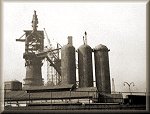|

4. An important by-product:
basic slag fertiliser
The article now turns to
something else: a recent development by which Hickman’s have become
large scale manufacturers of fertiliser. But to describe this our
writer simply reproduces “some notes on ‘Basic Slag’” by Mr. W. Hyde
Barnett, “the firm’s representative in this department”. I will
follow the same example (but I have divided it up into paragraphs):
"Since the commencement of
the manufacture of steel by the ‘Thomas Gilchrist’ process, the
‘Bilston’ Basic Phosphate has achieved a wide reputation for its
uniform quality and extreme richness in phosphoric acid, as well as
for its high degree of fine meal. Year by year it has forged itself
ahead on its own merits, and to‑day it commands the highest price
ever yet obtained for Basic Slag.
"Owing to the largely
increased demand, the producers have been encouraged to spend some
thousands of pounds in extending their grinding works, and have now
more than doubled their former output. Notwithstanding the increased
facilities thus provided, the demand continues to be greater each
season than is within the capacity of the works to supply.
"Although it is the custom
of the trade to give a guarantee of from 38 to 45 per cent. of
phosphates, the ‘Bilston’ Basic Phosphate far exceeds this
proportion, reaching, in fact, as high as 46 to 48 per cent., and
averaging as much as 44 per cent. of this fertilising.
"Another most important
feature of the ‘Bilston’ Basic Phosphate is the degree of fineness
to which it has been reduced. To effect this process the latest
improved machinery has been introduced by its manufacturers, and by
this means the slag has been ground to the consistency of fine grade
flours, and in consequence the phosphoric acid is more readily
rendered available as plant food. As the activity of the phosphate
is quickened when the slag is ground to this fine state of division,
it is most essential always to procure a finely pulverised slag if
the user wishes to secure an ample supply of phosphoric acid for the
first crop. The proprietors of the ‘Bilston’ Basic Phosphate
guarantee their slag to contain from 85 to 90 per cent. of fine
meal, i.e., to pass through a sieve of 10,000 holes to the square
inch ; an average always exceeded, it practically amounting to 94
per cent. fine meal.
"Having thus demonstrated
that the ‘Bilston’ Basic Phosphate stands unrivalled in the market
for richness of phosphates and fineness of meal, we next direct
attention to its uses. Owing to the system of experimental farming
pursued throughout the different States of the Continent, Basic Slag
was held in general favour there long before it took root in this
country. Experiments were instituted in England as far back as 1885,
with great success, especially on grass lands. Nevertheless, the
British farmer, with the inherent conservatism of his race, was very
slow to take it up.
"The more enlightened
agriculturalists, however, began experiments on a small scale, and
in their turn made the results known with such satisfactory effect
that to‑day Basic Slag occupies the premier position among
fertilisers for grass lands. It sweetens the grass, quickens the
growth of clover, and improves the herbage generally; as the cattle
prefer to graze upon land dressed with this fertiliser. Moreover,
its lasting properties in the soil have been known to extend over a
period of three years, so that it is also the cheapest form of
phosphate yet introduced to agriculturalists.
"Having satisfied the
agricultural world as to its power on grass land beyond all
expectation, attention was directed by enterprising farmers,
agricultural societies, and county councils to its application to
arable land, and their experiments have been recorded in the leading
journals devoted to such subjects from time to time, the general
results of these tests proving eminently satisfactory.
"To‑day the producers have
to face the fact, as far as the ‘Bilston’ Phosphate is concerned,
that with all their facilities of output, they cannot manufacture
the fertiliser fast enough to keep pace with the requirements of
demand at home and abroad; and this notwithstanding a capacity for
producing 800 tons per week, the export to Germany alone last season
amounting to 6,000 tons."
This business of producing fertilizer from
the slag seems to have been run, originally, as part of Sir Alfred
Hickman’s main business but later to have been hived off as a
separate enterprise. This will have to be researched and recorded
elsewhere. Suffice it to note here that Hickmans found another use
for slag – making road stone which, when mixed with tar became
tarmac. Between them these two uses of slag pretty soon called for
more slag than could possibly come from the Bilston furnaces and it
was bought in from elsewhere, making it even more important to run
the businesses separately.
 |
|
 |
|
 |
Return to
the
factory in 1898 |
|
Return to
the
beginning |
|
Proceed to
1900-1919 |
|